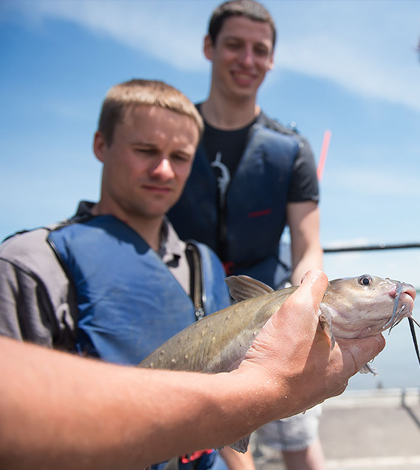U. Iowa Water Quality Class Brings Mississippi River Lessons To Life

The LACMRERS class is a hands-on experience for students. (Credit: University of Iowa)
Learning about things in a classroom can be fun, but book learning can only take students so far. Some need hands-on experience to really make the lessons stick. That principle is incredibly important for science courses, where paper-based information and tests just don’t hold a candle to getting out in the field to study.
In one real-world example of this method in practice, a teacher at the University of Iowa’s Lucille A. Carver Mississippi Riverside Environmental Research Station (LACMRERS) runs a summer field class that gets down into the nit and grit of water quality sampling on the Mississippi. The connections that it makes for students are just too valuable to pass up, he says. The summer field class began about seven years ago and has become extremely popular with students at the school.
“I think part of that is because it makes the connection between what they study in class and what they see in the field,” said Doug Schnoebelen, the water quality class instructor and director of LACMRERS. “They can make connections with the river by doing papers, etc., but I love when that light bulb comes on and they can see how whatever they’re studying is used.”
The list of things that students get to learn about in the class is quite extensive, and that makes sense because there are so many methods out there for assessing water quality and the creatures living in the Mississippi River. Some of the techniques that they get into include electrofishing, water sample collection and assessing streamflow measurements by looking at velocity and discharge. Students also learn to take sediment core samples.

A LACMRERS student takes a water sample from a side channel of the Mississippi River. (Credit: University of Iowa)
Sonar equipment is used to study locks and dams along the river, Schnoebelen says, and he tries to plan activities that allow students to learn about wells and their abilities to process nutrients going into the river. Looking at the interactions between groundwater and surface water is important, he says.
YSI and Hach water quality meters, OTT Hydrolab sondes and SonTek flow meters are some of the equipment used during sampling trips in the lab’s pontoon boat up and down the Mississippi River. These are done twice a week to reinforce classroom lessons with real-world examples. A partnership with a nearby Iowa Department of Natural Resources fish hatchery yields a research vessel used for catching fish. The vessel has been the setting of some great fishing stories, Schnoebelen says.
“We were doing some electrofishing one time and we caught a 60-pound flathead (catfish). One of the gals that caught it was a visitor from Iowa,” said Schnoebelen, chuckling while he recalled the big catfish. “She was a very petite young woman and I don’t know how they got that fish in the boat.”
In the lab, a number of different devices are used, mostly for sample analysis. These include pH meters, spectrophotometers and microscopes. Turner Designs fluorometers as well as Hach digital titrators are also used.
“It’s a nice mix between water quality, chemistry, the physics of flow composition and biology and ecology,” said Schnoebelen. “We try to touch on several things to give them a good overview and flavor for everything.”

LACMRERS director Doug Schnoebelen helps Austin Hummel use a spectrophotometer to test his river water sample for nitrates. (Credit: University of Iowa)
He adds that the students who take the class are also a good mix representing different majors and areas of study. Only juniors, seniors and graduate students can take the class, but they flock to it from majors like environmental science, civil engineering, geology, biology and others. Schnoebelen has even had public health majors take the course.
“I always go through the class at the beginning of the session and tailor the class to their needs,” said Schnoebelen. “It’s better that way. For example, if I have mostly engineering majors, I’ll teach it differently.”
Some of the points that he likes to make to students about the Mississippi River, regardless of their course of study, are related to the issues it faces. There’s always a tension on the Mississippi, he says, between its competing uses. The data students collect help play up the importance of those issues, helping them to grasp their significance better.
“One of the things I try to bring in is the interdisciplinary nature of the river. It runs through many states and is used for navigation, drinking water and is a major bird flyway,” said Schnoebelen. “We try to get into all those things just a little bit so they don’t focus on just one and can grow into other areas. It pushes them out of their comfort zone.”
The insights students gain, as well as the data they collect, are mostly used in the class, Schnoebelen says. And he works with them to tease out the nuances that the data yield. He shows them quality control methods, and then asks them what the data are telling them. He also tries to bring in data and findings from ongoing research projects at the university as much as he can. One of those, which he is helping on, is the Intensively Managed Landscapes Critical Zone Observatory. Backed by the National Science Foundation, it is the first critical zone observatory in the Midwest.
“I absolutely love teaching the class. The students respond so well because it helps make the connection to the river and the water,” said Schnoebelen. “It’s a lot of work, pretty intensive and a labor of love, but I truly enjoy it.”
Top image: The LACMRERS class is a hands-on experience for students. (Credit: University of Iowa)




0 comments